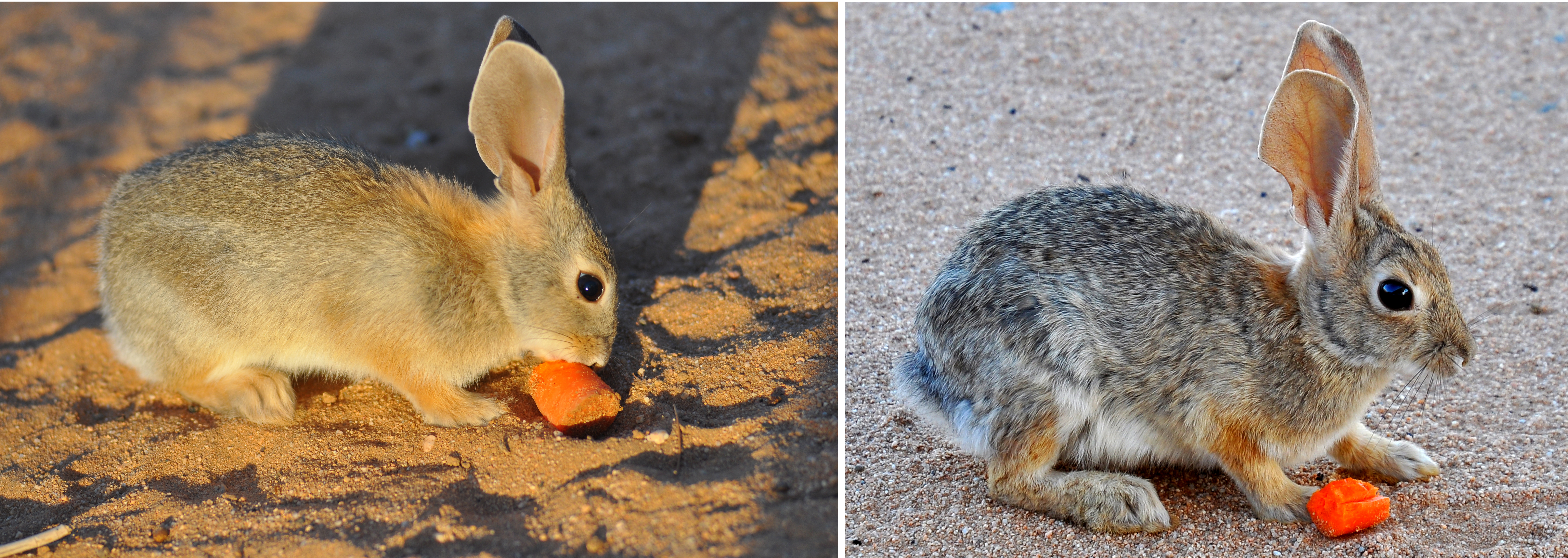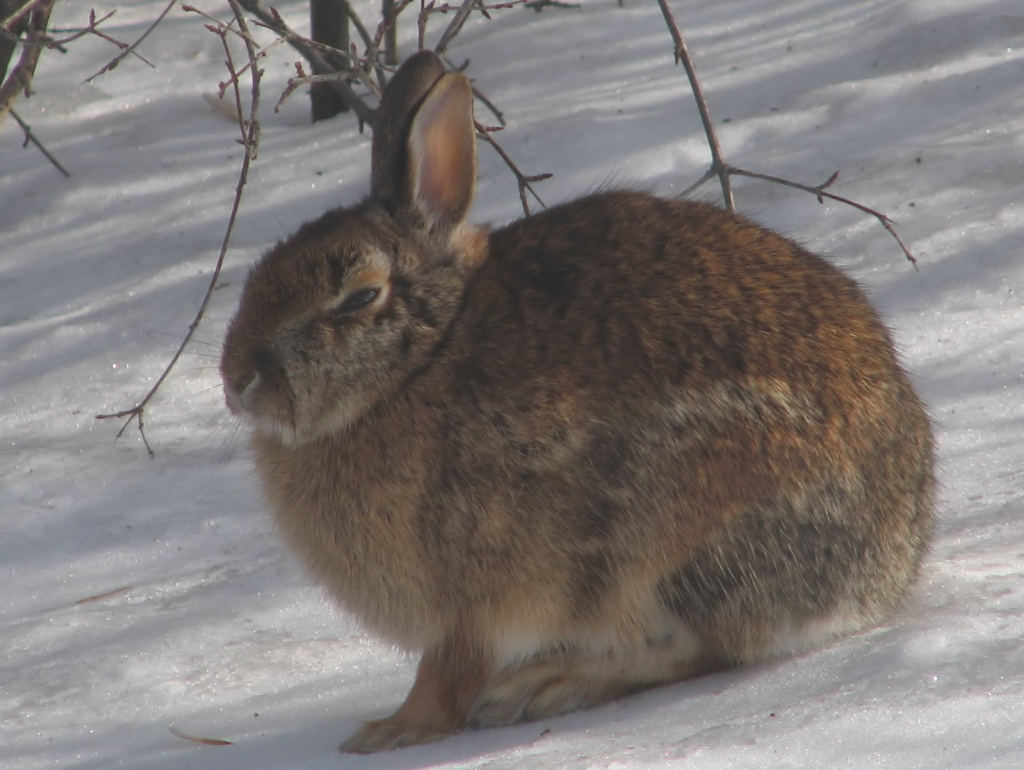|
Cottontail
Cottontail rabbits are the leporid species in the genus ''Sylvilagus'', found in the Americas. Most ''Sylvilagus'' species have stub tails with white undersides that show when they retreat, giving them their characteristic name. However, this feature is not present in all cottontails nor is it unique to the genus. The genus is widely distributed across North America, Central America and northern and central South America, though most species are confined to some particular regions. Most species live in nests called forms, and all have altricial young. An adult female averages three litters per year, which can occur in any season; occurrence, and litter size depend on several factors including time of the year, weather, and location. The average litter size is four but can range from as few as two to as many as eight, most of whom do not go on to survive to adulthood. Cottontail rabbits show a greater resistance to myxomatosis than European rabbits. Evolution Cottontails ... [...More Info...] [...Related Items...] OR: [Wikipedia] [Google] [Baidu] |
Sylvilagus Audubonii
The desert cottontail (''Sylvilagus audubonii''), also known as Audubon's cottontail, is a New World cottontail rabbit, and a member of the family Leporidae. Unlike the European rabbit (''Oryctolagus cuniculus''), they do not form social burrow systems, but compared with some other leporids, they are extremely tolerant of other individuals in their vicinity. Cottontails give birth to their kits in burrows vacated by other mammals. They sometimes cool off, or take refuge in scratched out shallow created depressions of their own making, using their front paws like a back hoe. They are not usually active in the middle of the day, but can be observed foraging in the early morning, and early evening. Cottontails are rarely found out of their burrows looking for food on windy days, because the wind interferes with their ability to hear approaching predators, their primary defense mechanism. Lifespan The lifespan of a cottontail that reaches adulthood averages less than two years, de ... [...More Info...] [...Related Items...] OR: [Wikipedia] [Google] [Baidu] |
Sylvilagus Transitionalis
The New England cottontail (''Sylvilagus transitionalis''), also called the gray rabbit, brush rabbit, wood hare, wood rabbit, or cooney, is a species of cottontail rabbit represented by fragmented populations in areas of New England, specifically from southern Maine to southern New York. This species bears a close resemblance to the eastern cottontail (''Sylvilagus floridanus''), which has been introduced in much of the New England cottontail home range. The eastern cottontail is now more common in it. Litvaitis et al. (2006) estimated that the current area of occupancy in its historic range is - some 86% less than the occupied range in 1960. Because of this decrease in this species' numbers and habitat, the New England cottontail is a candidate for protection under the Endangered Species Act. Cottontail hunting has been restricted in some areas where the eastern and New England cottontail species coexist in order to protect the remaining New England cottontail population. Rab ... [...More Info...] [...Related Items...] OR: [Wikipedia] [Google] [Baidu] |
Eastern Cottontail
The eastern cottontail (''Sylvilagus floridanus'') is a New World cottontail rabbit, a member of the family Leporidae. It is the most common rabbit species in North America. Distribution The eastern cottontail can be found in meadows and shrubby areas in the eastern and south-central United States, southern Canada, eastern Mexico, Central America and northernmost South America. It is also found on the Caribbean island of Margarita. It is abundant in Midwest North America. Its range expanded north as forests were cleared by settlers.Godin, Alfred J. (1977). ''Wild mammals of New England''. Baltimore, MD: The Johns Hopkins University Press Originally, it was not found in New England, but it has been introduced and now competes for habitat there with the native New England cottontail. It has also been introduced into parts of Oregon, Washington, and British Columbia. In the 1950s and 1960s, the eastern cottontail was introduced to France and northern Italy, where it displayed ... [...More Info...] [...Related Items...] OR: [Wikipedia] [Google] [Baidu] |
Sylvilagus Floridanus
The eastern cottontail (''Sylvilagus floridanus'') is a New World cottontail rabbit, a member of the family Leporidae. It is the most common rabbit species in North America. Distribution The eastern cottontail can be found in meadows and shrubby areas in the eastern and south-central United States, southern Canada, eastern Mexico, Central America and northernmost South America. It is also found on the Caribbean island of Margarita. It is abundant in Midwest North America. Its range expanded north as forests were cleared by settlers.Godin, Alfred J. (1977). ''Wild mammals of New England''. Baltimore, MD: The Johns Hopkins University Press Originally, it was not found in New England, but it has been introduced and now competes for habitat there with the native New England cottontail. It has also been introduced into parts of Oregon, Washington, and British Columbia. In the 1950s and 1960s, the eastern cottontail was introduced to France and northern Italy, where it displayed a rap ... [...More Info...] [...Related Items...] OR: [Wikipedia] [Google] [Baidu] |
Sylvilagus Obscurus
The Appalachian cottontail (''Sylvilagus obscurus'') is a species of cottontail rabbit in the family Leporidae. It is a rare species found in the upland areas of the eastern United States. Taxonomy The species was only recognized as separate from the New England cottontail (''Sylvilagus transitionalis'') in 1992. Description ''Sylvilagus obscurus'' is a small rabbit inhabiting mostly mountainous regions in the eastern U.S. ranging from Pennsylvania to South Carolina and being most prominent in the Appalachians. ''S. obscurus'' is better adapted to colder climates than its distant relative, ''S. floridanus'', the eastern cottontail. ''S. obscurus'' is light-yellow brown, mixed with black on the dorsal side, having a brown and red patch mixed on the neck. The ventral side is mostly white. ''S. obscurus'' is often visually quite similar to the eastern cottontail; a distinguishing factor is a black spot between the ears and a lack of a white spot on the forehead. The Appalachian c ... [...More Info...] [...Related Items...] OR: [Wikipedia] [Google] [Baidu] |
Sylvilagus Nuttallii
The mountain cottontail or Nuttall's cottontail (''Sylvilagus nuttallii'') is a species of mammal in the family Leporidae. It is found in Canada and the United States. Description The mountain cottontail is a small rabbit but its size is relatively large for the genus. Hind legs are long; the feet are densely covered with long hair. Ears are relatively short and rounded at the tips; the inner surfaces are noticeably haired.Chapman, Joseph A., 1975, ''Sylvilagus nuttallii'', Mammalian Species No. 56, The American Society of Mammalogists It has pale brown fur on the back, a distinct pale brown nape on the back of the head, black-tipped ears, a white-grey tail, and a white underside. The brown nape on the back of the head is a smaller size from than that of the Snowshoe Hare, helping to distinguish the two separate species from each other. Additionally, contrasting with the Snowshoe Hare’s long hops, the mountain cottontails take short distinctive leaps. Range This species i ... [...More Info...] [...Related Items...] OR: [Wikipedia] [Google] [Baidu] |
Sylvilagus Palustris
The marsh rabbit (''Sylvilagus palustris'') is a small cottontail rabbit found in marshes and swamps of coastal regions of the Eastern and Southern United States. It is a strong swimmer and found only near regions of water. It is similar in appearance to the eastern cottontail (''Sylvilagus floridanus'') but is characterized by smaller ears, legs, and tail. Terminology The scientific name ''Sylvilagus palustris'' derives from a combination of the Latin words ''silva'' ("forest") and ''lagos'' ("hare"), plus ''palustris'' ("of the marsh").Archibald William Smith The marsh rabbit has commonly been associated with the group of swamp rabbits; however, this name is not a synonym and should not be confused with the larger swamp rabbit ''(Sylvilagus aquaticus)'' of Alabama through Texas. Marsh rabbits have also often been referred to as ''marsh hares''. Phylogeny Subgenus ''Tapeti'' in the genus ''Sylvilagus'', marsh rabbits ''(S. palustris)'', and swamp rabbits ''(S. aquaticus)' ... [...More Info...] [...Related Items...] OR: [Wikipedia] [Google] [Baidu] |
European Rabbit
The European rabbit (''Oryctolagus cuniculus'') or coney is a species of rabbit native to the Iberian Peninsula (including Spain, Portugal, and southwestern France), western France, and the northern Atlas Mountains in northwest Africa. It has been widely introduced elsewhere, often with devastating effects on local biodiversity. Its decline in its native range due to myxomatosis, rabbit calicivirus, overhunting and habitat loss has caused the decline of the Iberian lynx (''Lynx pardinus'') and Spanish imperial eagle (''Aquila adalberti''). It is known as an invasive species because it has been introduced to countries on all continents with the exception of Antarctica, and has caused many problems within the environment and ecosystems; in particular, European rabbits in Australia have had a devastating impact, due in part to the lack of natural predators there. The European rabbit is well known for digging networks of burrows, called warrens, where it spends most of its ... [...More Info...] [...Related Items...] OR: [Wikipedia] [Google] [Baidu] |
Genus
Genus ( plural genera ) is a taxonomic rank used in the biological classification of living and fossil organisms as well as viruses. In the hierarchy of biological classification, genus comes above species and below family. In binomial nomenclature, the genus name forms the first part of the binomial species name for each species within the genus. :E.g. '' Panthera leo'' (lion) and '' Panthera onca'' (jaguar) are two species within the genus ''Panthera''. ''Panthera'' is a genus within the family Felidae. The composition of a genus is determined by taxonomists. The standards for genus classification are not strictly codified, so different authorities often produce different classifications for genera. There are some general practices used, however, including the idea that a newly defined genus should fulfill these three criteria to be descriptively useful: # monophyly – all descendants of an ancestral taxon are grouped together (i.e. phylogenetic analysis should c ... [...More Info...] [...Related Items...] OR: [Wikipedia] [Google] [Baidu] |
Leporid
Leporidae is the family of rabbits and hares, containing over 60 species of extant mammals in all. The Latin word ''Leporidae'' means "those that resemble ''lepus''" (hare). Together with the pikas, the Leporidae constitute the mammalian order Lagomorpha. Leporidae differ from pikas in that they have short, furry tails and elongated ears and hind legs. The common name "rabbit" usually applies to all genera in the family except ''Lepus'', while members of ''Lepus'' (almost half the species) usually are called hares. Like most common names, however, the distinction does not match current taxonomy completely; jackrabbits are members of ''Lepus'', and members of the genera '' Pronolagus'' and '' Caprolagus'' sometimes are called hares. Various countries across all continents except Antarctica and Australia have indigenous species of Leporidae. Furthermore, rabbits, most significantly the European rabbit, ''Oryctolagus cuniculus'', also have been introduced to most of Oceania and ... [...More Info...] [...Related Items...] OR: [Wikipedia] [Google] [Baidu] |
Sylvilagus Andinus
The Andean tapeti (''Sylvilagus andinus'') or Andean cottontail is a species of cottontail rabbit native to Colombia, Venezuela, Peru and Ecuador. It was previously considered a subspecies of the common tapeti (''Sylvilagus brasiliensis''). Living at high elevations in the treeless Páramo Páramo () can refer to a variety of alpine tundra ecosystems located in the Andes Mountain Range, South America. Some ecologists describe the páramo broadly as "all high, tropical, montane vegetation above the continuous timberline". A narrowe ... of the Andes, analysis in 2017 confirmed that it is sufficiently distinct in both appearance and genetics to be considered a species in its own right. Although widespread, it remains poorly known, as few studies have been conducted on its biology and habits as distinct from those of the tapeti References {{Taxonbar, from=Q85741588 Sylvilagus Mammals of Brazil Mammals described in 1897 ... [...More Info...] [...Related Items...] OR: [Wikipedia] [Google] [Baidu] |




.jpg)
.jpg)

_(Sylvilagus_palustris).jpg)

